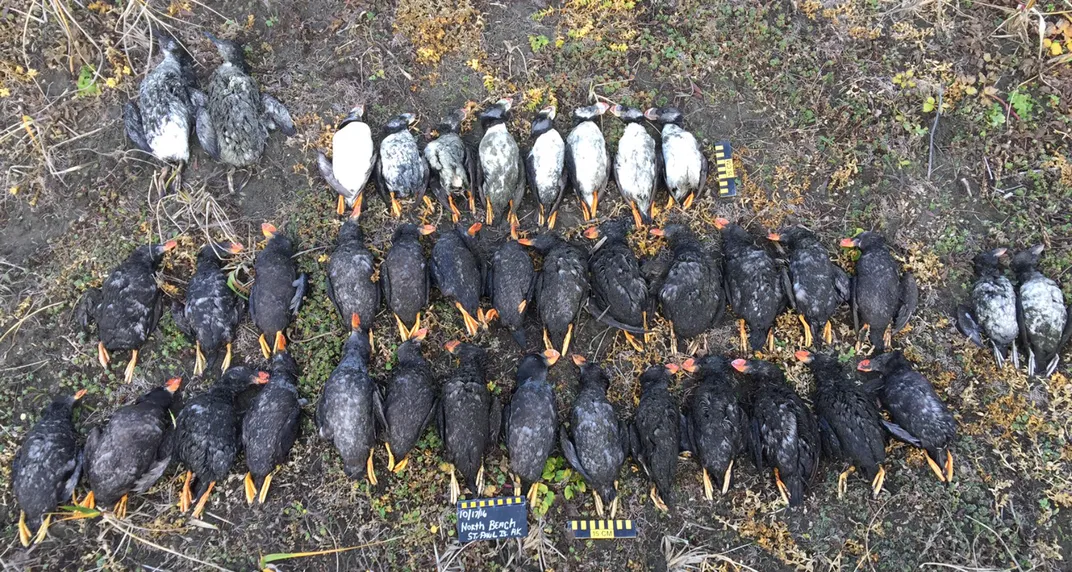Why Have Thousands of Puffins and Other Seabirds Died En Masse in the Bering Sea?
The cause of the 2016 die-off, according to a new study, was likely climate change
/https://tf-cmsv2-smithsonianmag-media.s3.amazonaws.com/filer/19/28/19288437-7268-43b2-953c-6bed2455b099/gettyimages-1084644800.jpg)
Seabirds are an important indicator of marine ecosystem health—and in 2016, signs began to emerge that something was very, very wrong in the eastern Bering Sea. Around 350 dead seabirds, most of them tufted puffins, washed onto Alaska’s St. Paul Island, shocking residents and experts.
“[Y]ou couldn’t walk more than a few steps before having to pick up another bird,” Lauren Divine, director of the Aleut Community of St. Paul Island Ecosystem Conservation Office, tells the Atlantic’s Ed Yong.
And the number of dead birds on St. Paul may represent just a fraction of the total birds that lost their lives between 2016 and 2017. In a new study published in PLOS One, a team of researchers used the locations of the bodies and weather data to estimate that between 3,150 and 8,800 seabirds in the eastern Bering Sea perished—a mass die-off that, according to the study authors, is at least partly attributable to climate change.
Of all the dead birds that were found on St. Paul, 79 percent were tufted puffins, which are larger than other puffin species and distinguished by their flowing, golden head plumes. Crested auklets, a “chunky” Alaskan seabird, made up 11 percent of the carcasses, and a number of horned puffins and murres were also found. The birds were, according to the study authors, “severely emaciated,” suggesting that they had died of starvation.

The birds’ annual patterns also appeared to be off-kilter. The unfortunate animals began washing ashore in October, a time when seabirds in the St. Paul area have typically migrated to warmer waters, according to Brady Dennis of the Washington Post.
Most of the tufted puffins were in mid-molt, a process in which birds lose their feathers and replace them with new ones. Molting is a stressful period because it increases birds’ energy needs but also reduces their ability to fly and dive, making it difficult to find food. Tufted puffins typically molt between August and October, once they have already migrated to winter foraging grounds. The St. Paul puffins, in other words, seem to have been molting late. And during this vulnerable period, when having an abundant and easily accessible food source is crucial, they did not seem able to find enough prey.
Other mass-die offs of seabirds—which are aptly known as “wrecks”—have been recorded in northern Pacific waters in recent years. According to the National Parks Service, 2018 marked the third year in a row that Alaska experienced “extreme” mortality events that affected a number of species, including common murres, short-tailed shearwaters, Northern fulmars and puffins. These events, according to the study authors, are “cumulatively suggestive of broad-scale ecosystem change.”
In the case of the St. Paul puffins, the trouble may have stemmed from warming waters and a reduction of ice in the Bering Sea. Cold-water plankton are not adapting well to warmer oceans, and the fish that eat them are migrating to other regions in search of food. This in turn reduces prey availability for seabirds that feed on coldwater fish like pollock and capelin.
What’s more, The Atlantic's Yong reports, sea ice creates a layer of cold water near the bottom of the Bering where fish like to congregate, making it an excellent feeding ground for seabirds. But the so-called “cold pool” has not been forming in recent years, causing fish to spread out over larger distances and making them harder to catch. And the fish that can be caught are less calorie-rich because they are eating smaller plankton—a damaging ripple effect that means seabirds “are going from Clif Bars to rice cakes,” study co-author Julia Parrish tells Yong.
Questions still remain about the 2016 die-off. The Bering sea is a complex ecosystem, and it’s difficult to pinpoint a precise cause, as Parrish tells Dennis of the Washington Post. But it does seem clear that the seabirds around St. Paul Island are being impacted by a changing environment—and whether they will be able to withstand these changes remains to be seen.